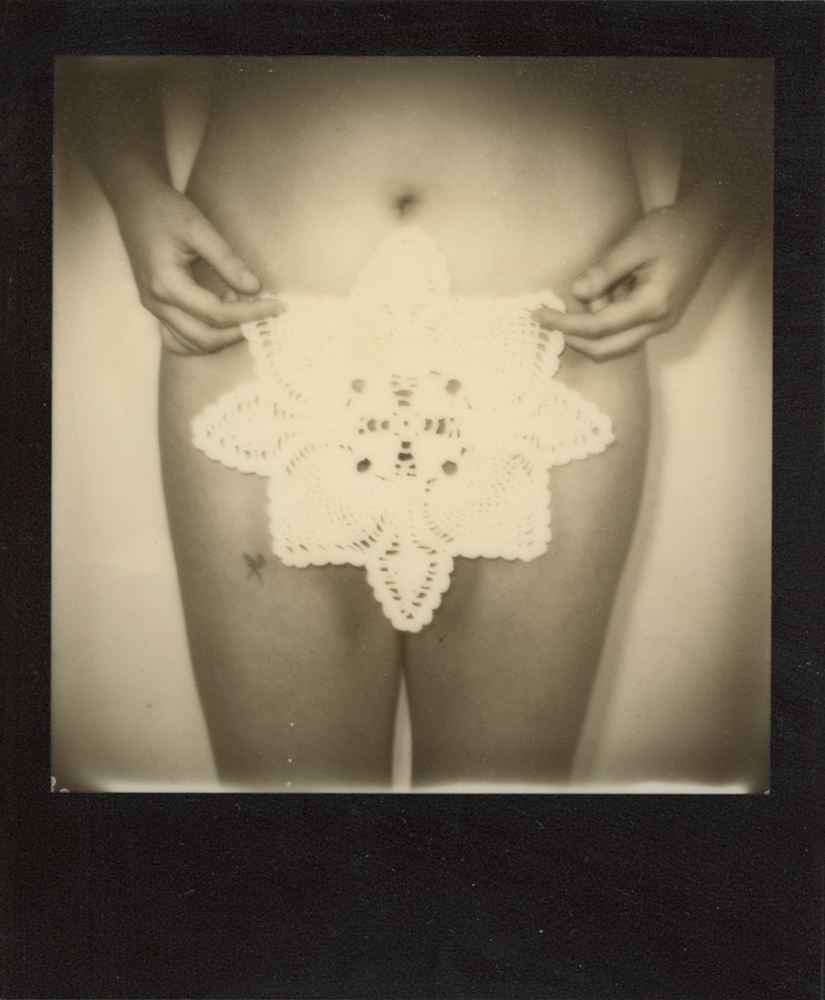Polaroid Week: Rachel Portesi: Standing Still
I was introduced to the work of Rachel Portesi this September, through her solo show at the Griffin Museum of Photography. Standing Still features selections drawn from her ongoing series of “hair portraits” in which she address fertility, sexuality, creativity, nurturing, harmony, and discord, using various formats including wet plate tintypes, Polaroids, and 3-d viewers. This is the final week of that exhibition, closing on October 30, and if you’re anywhere near Winchester, Massachusetts you should see it. (If not, you can catch her online artist talk on Tuesday, November 8, 7 to 8 pm Eastern / 4pm Pacific.)
Polaroids have been part of Rachel’s practice for decades, starting with land camera documentary work that spans two decades. Her recent use of the medium has a more conceptual bent, featuring elaborately staged portraits and feminist humor. In her own words, she is now using the process to “explore the nuanced transitions in female identity related to motherhood, aging, and choice as well as the intersection of identity and femininity with the physical world.”
Upcoming Exhibitions:
Videos:
https://youtube.com/shorts/CFMUQXFB-XA?feature=share
https://youtube.com/shorts/oHwZXNcPsXE?feature=share
Rachel Portesi received a BA in Sociology and Photography from Marlboro College,VT. Her recent work in tintype, Polaroid, 3-D imagery and video installation explores how female identity is redefined by motherhood and aging. Portesi’s photographs have been exhibited at various venues in New England and in New York, and have been written about in Vogue, Forbes, Boston Globe and Musée magazines among others. She works and lives with her family in Saxtons River, Vermont.
Follow Rachel Portesi on Instagram: @rachel.portesi
I’m a child of the 70’s. Polaroids were everywhere. The first time I shot an old Polaroid 195 land camera was so exciting and I thought to mark the date along the white edge of the black and white 667 film: October 15th, 1995. Somehow, I knew I was starting something important—in an instant. I love everything about shooting instant film, of course, there’s the magic of an image appearing before my eyes, but mostly, I think, I was drawn to the Polaroid’s immediacy and the ease it allowed for sharing the fun with my subjects and friends. Traditional analog and digital film processes tied me down in the dark room or studio for hours editing small details that never seemed to matter much. Polaroid represents freedom. With instant photography, you get what you get all in a moment. Mistakes and inconsistencies become part of the whole, much like life itself. Kintsugi, the Japanese art of pottery that celebrates the flaws comes to mind too. For many years Polaroid film was unavailable, and during that time I discovered the tintype, an archaic way of making instant images. Instant photography interests me for the lack of control, and the mysterious emergence of the final image. They’re like a magic tricks. Because there is no negative each Polaroid and tintype is an original. Polaroids are pure fun, and the work feels like play. If what Sartre said in “No Exit” is right, and we all have our own unique versions of heaven and hell—then my heaven is full of free and available Polaroid film.

©Rachel Portesi, Chandelier Hair (grid) 2019-2022 Polaroid I-Type B&W, black frame film 16 ¼ x 17 ¾ in.
Posts on Lenscratch may not be reproduced without the permission of the Lenscratch staff and the photographer.
Recommended
-
Nathan Bolton in Conversation with Douglas BreaultJanuary 3rd, 2026
-
Salua Ares: Absense as FormNovember 29th, 2025
-
Ricardo Miguel Hernández: When the memory turns to dust and Beyond PainNovember 28th, 2025
-
Pamela Landau Connolly: Columbus DriveNovember 26th, 2025











































































